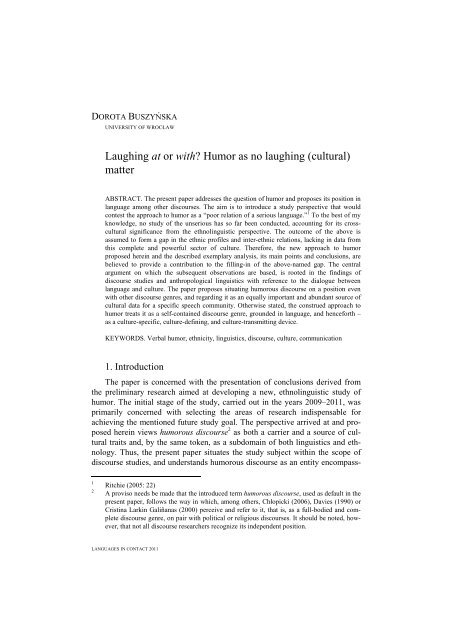s - Wyższa SzkoÅa Filologiczna we WrocÅawiu
s - Wyższa SzkoÅa Filologiczna we WrocÅawiu
s - Wyższa SzkoÅa Filologiczna we WrocÅawiu
You also want an ePaper? Increase the reach of your titles
YUMPU automatically turns print PDFs into web optimized ePapers that Google loves.
DOROTA BUSZYŃSKA<br />
UNIVERSITY OF WROCŁAW<br />
Laughing at or with? Humor as no laughing (cultural)<br />
matter<br />
ABSTRACT. The present paper addresses the question of humor and proposes its position in<br />
language among other discourses. The aim is to introduce a study perspective that would<br />
contest the approach to humor as a “poor relation of a serious language.” 1 To the best of my<br />
knowledge, no study of the unserious has so far been conducted, accounting for its crosscultural<br />
significance from the ethnolinguistic perspective. The outcome of the above is<br />
assumed to form a gap in the ethnic profiles and inter-ethnic relations, lacking in data from<br />
this complete and po<strong>we</strong>rful sector of culture. Therefore, the new approach to humor<br />
proposed herein and the described exemplary analysis, its main points and conclusions, are<br />
believed to provide a contribution to the filling-in of the above-named gap. The central<br />
argument on which the subsequent observations are based, is rooted in the findings of<br />
discourse studies and anthropological linguistics with reference to the dialogue bet<strong>we</strong>en<br />
language and culture. The paper proposes situating humorous discourse on a position even<br />
with other discourse genres, and regarding it as an equally important and abundant source of<br />
cultural data for a specific speech community. Otherwise stated, the construed approach to<br />
humor treats it as a self-contained discourse genre, grounded in language, and henceforth –<br />
as a culture-specific, culture-defining, and culture-transmitting device.<br />
KEYWORDS. Verbal humor, ethnicity, linguistics, discourse, culture, communication<br />
1. Introduction<br />
The paper is concerned with the presentation of conclusions derived from<br />
the preliminary research aimed at developing a new, ethnolinguistic study of<br />
humor. The initial stage of the study, carried out in the years 2009–2011, was<br />
primarily concerned with selecting the areas of research indispensable for<br />
achieving the mentioned future study goal. The perspective arrived at and proposed<br />
herein views humorous discourse 2 as both a carrier and a source of cultural<br />
traits and, by the same token, as a subdomain of both linguistics and ethnology.<br />
Thus, the present paper situates the study subject within the scope of<br />
discourse studies, and understands humorous discourse as an entity encompass-<br />
1<br />
2<br />
Ritchie (2005: 22)<br />
A proviso needs be made that the introduced term humorous discourse, used as default in the<br />
present paper, follows the way in which, among others, Chłopicki (2006), Davies (1990) or<br />
Cristina Larkin Galiñanas (2000) perceive and refer to it, that is, as a full-bodied and complete<br />
discourse genre, on pair with political or religious discourses. It should be noted, ho<strong>we</strong>ver,<br />
that not all discourse researchers recognize its independent position.<br />
LANGUAGES IN CONTACT 2011
















